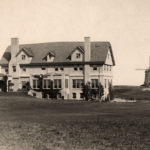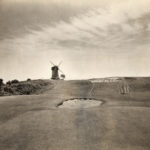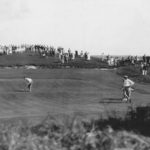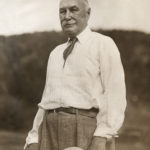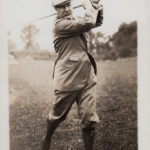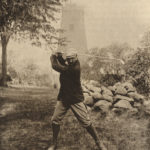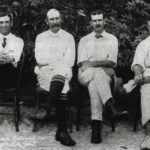
Charles Blair Macdonald (2020)
About Charles Blair Macdonald (2020)
To call Charles Blair Macdonald a giant of American golf is a gross understatement. The game in this country would be unrecognizable without him, and his influence is on display wherever we put a tee in the ground.
He was a great player (winner of the first U.S. Amateur), visionary (the prime motivator behind formation of the USGA), builder (responsible for the first 18-hole course in America), and architect with especially strong representation in the Met Area (National Golf Links of America, The Creek, Piping Rock, Blind Brook, and Sleepy Hollow, as well as the original courses for Deepdale and Lido). Outside of our area he was intimately involved with the Mid-Ocean Club in Bermuda, Yale Golf Club, Chicago Golf Club, St. Louis Country Club, Onwentsia, and the Old White course at the Greenbrier.
The child of a Scottish father and Canadian mother (both naturalized U.S. citizens), Macdonald was born in 1855 in Niagara Falls, Ontario, and grew up in Chicago. As a teenager he was sent to study at the university in St. Andrews, where he learned the game under the tutelage of Old Tom Morris and played matches against Young Tom. He took advantage of his success as a stockbroker to return to the British Isles frequently and travel on the European continent as well, observing not merely how the game was played but also what types of golf holes made for pleasing competition. He saw first-hand the mix of physical and mental challenges posed by great golf design, and wanted to demonstrate to Americans that intelligent design meant more than simply placing obstacles in the golfer’s path.
He chose a swath of Southampton for his grand showplace, and hired a civil engineer named Seth Raynor to do a boundary survey of the property and ultimately to figure out how to put his plans into action. Macdonald’s goal was nothing less than creating the ideal golf course: eighteen outstanding holes each of which replicated – sometimes in literal form, sometimes in principle – the strategies presented by the best holes he had played across the ocean. In many cases he improved upon them: his Redan at National is far superior to the original at North Berwick, and designers today are influenced far more by Macdonald’s adaptation than the blind original version.
Macdonald’s “template holes” have served as inspirations to course designers ever since: Alps, Sahara, Eden, Bottle, Short, Long, St. Andrews (patterned after the Road Hole) – these were all introduced to the U.S. at Macdonald’s club on Long Island. So were some of the master’s own creations, like the Cape Hole 14th – since altered at National but still going strong in the Atlantic at Mid-Ocean.
A few years later Macdonald and Raynor took on a more formidable engineering challenge, creating the now-legendary Lido Golf Club on Long Island’s south shore (described in detail in The Met Golfer of February/March 2016). Rather than adapting a piece of property for golf purposes, Macdonald was free to design the course however he wanted, relying on Raynor to do the dredging and molding to make the land fit the plan. The course was by all accounts a wonder of the modern age, one ranked by Bernard Darwin alongside National and Pine Valley as the finest in America. When the Depression hit, however, it fell into disrepair, and vanished forever in the 1940s; Bandon Dunes impresario Mike Keiser is one of many to express a desire to recreate it if a suitable site can be found. (The public course in Lido Beach is on a different plot of land and has no relation to the earlier club.)
As a man, Macdonald could fairly be described as “imperious” – or as one observer put it, “If he hadn’t been such a distinguished looking, financially solid citizen, he might have been referred to as ‘bull-headed.’ As it was, he was respectfully termed ‘opinionated.’” Legend has it that he took suggestions from members of NGLA – his club, after all — very seriously, and after making the suggested alteration (a new card room for the clubhouse, or building the windmill beside the 16th green), he would send that member a bill for the costs. He made a $20 bet with his own grandson, J. Peter Grace, about whether the first green could be reached from the tee – and when the latter successfully drove it on his third attempt, Macdonald paid up, and then wrote him out of his will the next morning.
Fortunately for our understanding of the game, one of Macdonald’s interests was writing, and he authored Scotland’s Gift: Golf, a book of reminiscences about the first decades of golf in America, his experiences in St. Andrews, the thoughts and philosophies behind the holes and courses he designed, as well as correspondence and reflections on the development of the Rules.
Macdonald died in Southampton on April 21, 1939. He was survived by his daughter, Frances, who was married to Henry Whigham – the man who succeeded Macdonald as U.S. Amateur champion. The simplest and truest summation of his contributions is contained in the title of an article Whigham wrote for Town & Country, the magazine he edited, after Macdonald’s passing: The Evangelist of Golf.
Text from the November/December 2020 issue of The Met Golfer.
Photos Courtesy USGA.
Leaving His mark on the Met Area…
C.B. Macdonald was responsible for building the first 18-hole course in America, and left his mark in the Met Area , designing a number of prominent golf courses.
Met Area Macdonald Courses:
- National Golf Links of America
- The Creek
- Piping Rock
- Blind Brook
- Sleepy Hollow
- Original Designs of Lido and Deepdale
ADDITIONAL DETAILS & MULTIMEDIA
Life Events
- Date of Birth: November 14, 1855
- Date of Death: April 21, 1939 (aged 83)
- Hometown: Chicago, Illinois
- Club Affiliation: Chicago Golf Club
Achievements
- Won the inaugural U.S. Amateur
- Founding Member of the USGA
- World Golf Hall of Fame, Lifetime Achievement category, Class of 2007

